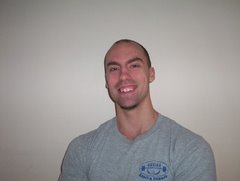
As I type this blog, I am literally in the middle of grilling a huge package of chicken breast that I marinated a couple of hours ago. I just got done training and have to leave shortly to catch the train into Boston to go to work. Hold on one sec........................................................
Okay, I'm back. Had to go flip my chicken outside. Smells delicious.
Brie Boyer (ranked 12th overall in the world, and 3rd in the US in the Skeleton) is currently staying at mine and Eric Cressey's apartment this week getting some off-season training done at Excel Sport and Fitness in her attempt to switch over to bobsledding for the next Winter Olympics. I came home last night and walked into our kitchen to see an entire fridge full of fresh vegetables (spinach, tomatoes, onions, peppers, etc), fresh fruit (plums, peaches, apples), a few packages of lean ground turkey/beef, cottage cheese, various mixed nuts, and plethora of other quality food items. Additionally, Brie was nice enough to buy a new fan for our living room. YES!
The point of all of this is that we don't make excuses. We both know how and what we're supposed to eat and we get it done. No questions asked. In talking with Brie last night, she mentioned that one of the first things she did when she came here was to find the local grocery store so that she could get the food she needed to cook and pack each day.
We all make sacrifices. I don't necessarily enjoy spending time every day packing my meals and cooking food ahead of time, but I just accept it as something that needs to be done. Point. Blank. Period.
If you want to take your body to the next level, you MUST learn to accept the fact that you have to prepare for success. Fill your fridge with the proper foods, cook your meat ahead of time so that you save time in the long run, bring meals/snacks with you to work. Suck it up and just do it. If an Olympic athlete who trains everyday, works a part-time job, AND travels can do it......so can you.








